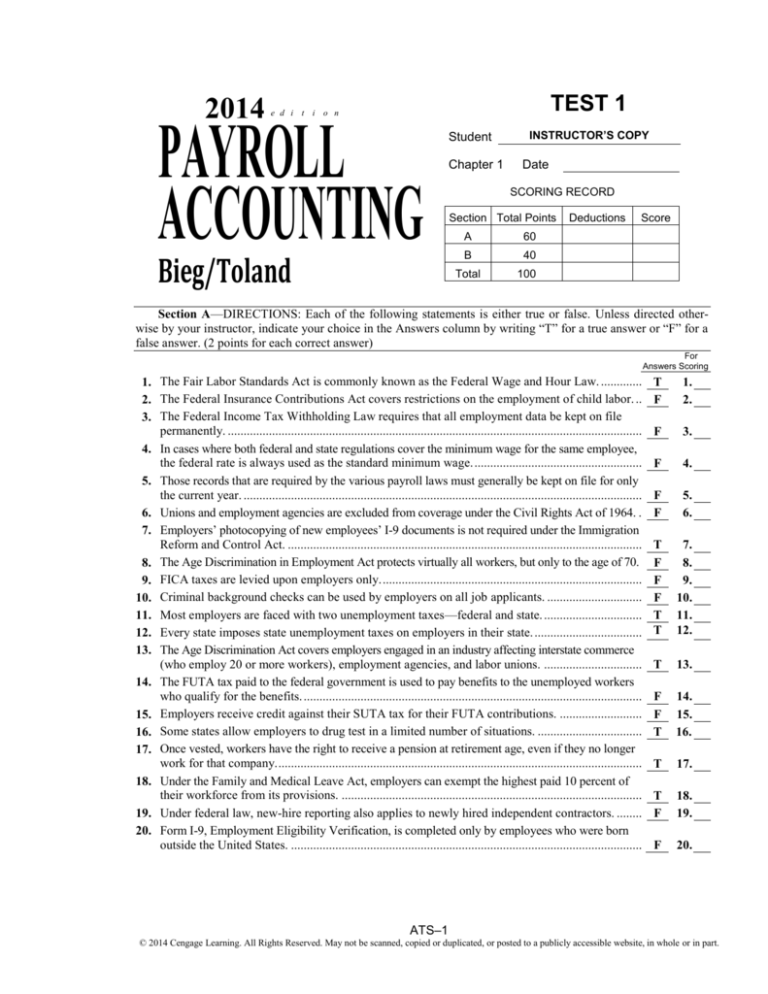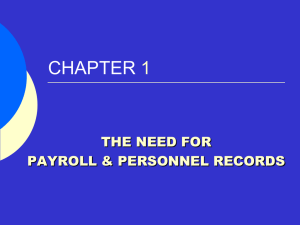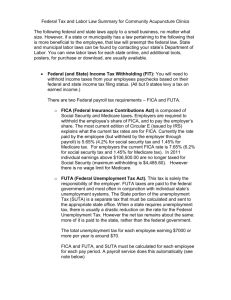
2014
TEST 1
e d i t i o n
PAYROLL
ACCOUNTING
Bieg/Toland
Student
Chapter 1
INSTRUCTOR’S COPY
Date
SCORING RECORD
Section Total Points
A
60
B
40
Total
100
Deductions
Score
Section A—DIRECTIONS: Each of the following statements is either true or false. Unless directed otherwise by your instructor, indicate your choice in the Answers column by writing “T” for a true answer or “F” for a
false answer. (2 points for each correct answer)
For
Answers Scoring
1. The Fair Labor Standards Act is commonly known as the Federal Wage and Hour Law. ..................T
2. The Federal Insurance Contributions Act covers restrictions on the employment of child labor. .......F
3. The Federal Income Tax Withholding Law requires that all employment data be kept on file
permanently. ........................................................................................................................................F
4. In cases where both federal and state regulations cover the minimum wage for the same employee,
the federal rate is always used as the standard minimum wage. ..........................................................F
5. Those records that are required by the various payroll laws must generally be kept on file for only
the current year. ...................................................................................................................................F
6. Unions and employment agencies are excluded from coverage under the Civil Rights Act of 1964. .......F
7. Employers’ photocopying of new employees’ I-9 documents is not required under the Immigration
Reform and Control Act. .....................................................................................................................T
8. The Age Discrimination in Employment Act protects virtually all workers, but only to the age of 70. F
9. FICA taxes are levied upon employers only. .......................................................................................F
10. Criminal background checks can be used by employers on all job applicants. ...................................F
11. Most employers are faced with two unemployment taxes—federal and state. ....................................T
12. Every state imposes state unemployment taxes on employers in their state. .......................................T
13. The Age Discrimination Act covers employers engaged in an industry affecting interstate commerce
(who employ 20 or more workers), employment agencies, and labor unions. ....................................T
14. The FUTA tax paid to the federal government is used to pay benefits to the unemployed workers
who qualify for the benefits. ................................................................................................................F
15. Employers receive credit against their SUTA tax for their FUTA contributions. ...............................F
16. Some states allow employers to drug test in a limited number of situations. ......................................T
17. Once vested, workers have the right to receive a pension at retirement age, even if they no longer
work for that company. ........................................................................................................................T
18. Under the Family and Medical Leave Act, employers can exempt the highest paid 10 percent of
their workforce from its provisions. ....................................................................................................T
19. Under federal law, new-hire reporting also applies to newly hired independent contractors. .............F
20. Form I-9, Employment Eligibility Verification, is completed only by employees who were born
outside the United States. ....................................................................................................................F
1.
2.
3.
4.
5.
6.
7.
8.
9.
10.
11.
12.
13.
14.
15.
16.
17.
18.
19.
20.
ATS–1
© 2014 Cengage Learning. All Rights Reserved. May not be scanned, copied or duplicated, or posted to a publicly accessible website, in whole or in part.
ATS–2
Chapter 1/Achievement Test Solutions
SECTION A (continued)
For
Answers Scoring
21. The deadline for an employee to complete Form I-9 is one year from the date of hire. ......................
22. Under the Family and Medical Leave Act, an employer can substitute an employee’s earned paid
leave for any part of the 12-week family leave. ...................................................................................
23. Workers’ compensation insurance applies only to work-related injury, illness, or death. ...................
24. Prehire questions pertaining to religion, gender, national origin, or age are allowed when these
factors are bona fide occupational requirements for a job. ...................................................................
25. In the event employment is denied because of the information obtained from an investigative consumer report, the employer is required to inform the individual that this was the reason for denying
employment. ........................................................................................................................................
26. Employers cannot terminate an employee for providing false information on an application form
once the employee begins employment................................................................................................
27. The hiring notice is a written record sent to the Payroll Department so that the new employee can be
added to the payroll. .............................................................................................................................
28. The payroll register is used by employers in preparing Form W-2, the wage and tax statement sent to
each employee at year-end. ..................................................................................................................
29. The payroll register is used to provide the information needed to record the payroll entries made in
the journal on each payday. ..................................................................................................................
30. The FLSA requires all employees to be paid weekly. .................................................................
F
21.
T
T
22.
23.
T
24.
T
25.
F
26.
T
27.
F
28.
T
F
29.
30.
Section B—DIRECTIONS: Complete each of the following sentences by writing in the Answers column the
letter of the word or words that correctly completes each statement. (5 points for each correct answer)
For
Answers Scoring
1. Which of the following laws establishes the minimum wage? (A) Fair Labor Standards Act,
(B) Federal Personal Responsibility and Work Opportunity Reconciliation Act, (C) Federal Insurance
Contributions Act, (D) Federal Unemployment Tax Act, (E) Fair Employment Laws. ......................
2. Which of the following bases for discrimination in employment practices is not covered in Title VII of the
Civil Rights Act of 1964 as amended? (A) Color, (B) Religion, (C) Age, (D) Sex, (E) National origin .....
3. Which of the following acts covers employee pension and welfare plans? (A) Federal Unemployment Tax Act, (B) Federal Insurance Contributions Act, (C) Age Discrimination in Employment
Act, (D) Family and Medical Leave Act, (E) Employee Retirement Income Security Act. ................
4. Medicare is a two-part health insurance program that was part of an amendment to what act?
(A) Federal Insurance Contributions Act, (B) Federal Income Tax Withholding Law, (C) Federal
Unemployment Tax Act, (D) Affordable Care Act, (E) Fair Labor Standards Act .............................
5. Which of the following statements is not a provision of ERISA? (A) ERISA applies to pension and
welfare plans established by any employer engaged in commerce. (B) ERISA establishes minimum
vesting schedules that protect the workers’ benefits. (C) ERISA provides that all employees are
eligible to set up their own individual retirement accounts. (D) ERISA requires each employer to
establish a pension plan. (E) All of the above are provisions of ERISA. ............................................
6. Which of the following acts deals with the minimum wage paid to laborers for contractors who
supply materials to any agency of the United States? (A) Davis-Bacon, (B) Walsh-Healey Public
Contracts, (C) Federal Insurance Contributions, (D) McNamara-O’Hara Service Contract, (E) None
of these. ................................................................................................................................................
7. Which of the following forms is used to complete each employee’s Form W-2, Wage and Tax
Statement? (A) Payroll register, (B) Employee’s paycheck, (C) Change in payroll rate form,
(D) Employee’s individual retirement account, (E) Employee’s earnings record ...............................
8. Which of the following items does not always appear on both the payroll register and the employee’s
earnings record in the weekly payroll recording? (A) Gross weekly pay, (B) Net amount of the paycheck, (C) Federal income tax deducted, (D) Cumulative earnings, (E) All of the above appear on
both records. ........................................................................................................................................
A
1.
C
2.
E
3.
A
4.
D
5.
B
6.
E
7.
D
8.
© 2014 Cengage Learning. All Rights Reserved. May not be scanned, copied or duplicated, or posted to a publicly accessible website, in whole or in part.








